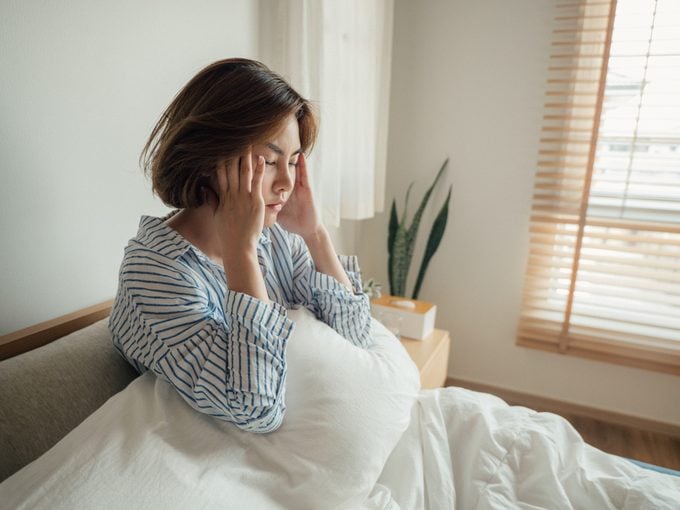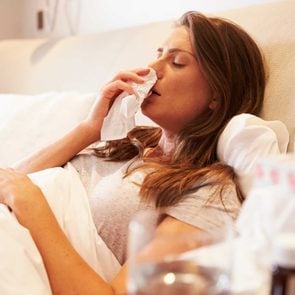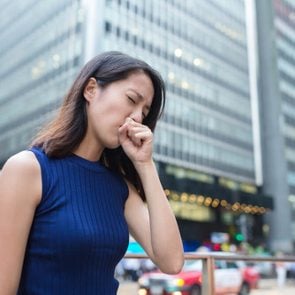What Is Walking Pneumonia? Symptoms, Diagnosis, and Treatment
Updated: Mar. 30, 2022
Also called atypical pneumonia, walking pneumonia is a different type of upper respiratory infection than regular pneumonia in a few key ways.
What is walking pneumonia?
You’re coughing and your chest hurts and it doesn’t seem to quit. You’ve probably heard the term “walking pneumonia”—is that be what you have?
Walking pneumonia is the common name for a condition known medically as atypical pneumonia. Regular pneumonia is a lower-respiratory tract infection most commonly caused by strep or staph bacteria (but can also be caused by viruses or fungi). Walking pneumonia is caused by atypical or unusual bacteria, most commonly Mycoplasma pneumoniae, says Chidinma Chima-Melton, MD, a board-certified pulmonologist and assistant clinical professor of pulmonary and critical care medicine at the David Geffen School of Medicine at UCLA.
People who have walking pneumonia don’t tend to get as sick as those with regular run-of-the-mill pneumonia, Dr. Chima-Melton adds. While regular pneumonia usually makes people really sick—like, unable to get out of bed or needing to be hospitalized—walking pneumonia is usually mild enough that you can carry on with your life. Kind of like how a bad cold makes you feel crummy, but you can still function.
According to the Centers for Disease Control and Prevention (CDC), there’s no national reporting system for mycoplasma pneumonia. So it’s impossible to know just how common walking pneumonia is. But estimates suggest about 2 million people come down with mycoplasma pneumonia each year in the U.S. By comparison, about 1.3 million people were diagnosed with regular pneumonia in emergency room visits in 2017.
Risk factors
Walking pneumonia is spread via respiratory droplets among people in very close contact. It’s not so contagious that you’re likely to get it after being with someone who has it for a short period of time. More commonly, it spreads among people who live together—like in college dorms and military barracks. Because of this, it tends to be more common in young adults, Dr. Chima-Melton says.
Some underlying conditions can put you at risk for developing any type of pneumonia, including walking pneumonia. “Asthma is the most prominent one,” says Melodi Pirzada, MD, chief of pediatric pulmonology at NYU Langone Hospital—Long Island, in New York. Older adults are at an increased risk for getting seriously ill, even from the milder atypical pneumonia.
Other chronic health conditions, including being immunocompromised, diabetes, and poorly controlled high blood pressure tend to be risk factors for all types of pneumonia, including walking pneumonia, says Dr. Chima-Melton.
How it’s diagnosed
“The diagnosis can be quite challenging because it presents as any other lower respiratory tract infection,” Dr. Pirzada says. But since the right treatment will depend on what type of infection you have, it’s important to get an accurate diagnosis.
To diagnose walking pneumonia, your doctor can swab and test phlegm from the nose or throat. They may also do a blood test. A chest X-ray can show what’s going on in the lungs and show the amount of inflammation. But it can’t get to the bottom of which organism caused the infection the way the other tests can.

Symptoms of walking pneumonia
It can take anywhere from one to two weeks for symptoms of walking pneumonia to show up after you’ve been infected. “You might feel like you have a bit of a cold or are under the weather,” Dr. Chima-Melton says. “But you may not necessarily feel short of breath, run down, or have chills or fever as you’d have with regular pneumonia.”
The most common symptoms of walking pneumonia include:
- Cough
- Fatigue
- Fever and chills
- Shortness of breath
- Chest pain
If those sound really similar to the symptoms of Covid-19, that’s because they are. They’re also very much like symptoms of the flu.
“Without testing, it’s almost impossible to clinically distinguish between them,” Dr. Chima-Melton says. “So while we’re in a pandemic, the safest thing to do is just to get a Covid-19 test and ensure it’s not that first.”
How it’s treated
Walking pneumonia is very treatable with antibiotics. Specifically, a type of antibiotics called macrolide antibiotics are used, Dr. Pirzada says. Common macrolide antibiotics include azithromycin, clarithromycin, erythromycin, and roxithromycin. Depending on the exact antibiotic, treatment typically ranges from five to 10 days, she says. A bad cough can linger for weeks, or even months, especially for those who have preexisting lung conditions.
According to the CDC, most people will recover from walking pneumonia on their own—meaning, they don’t need antibiotics and their bodies fight the infection naturally. But it depends on a person’s immune system.
And on the flipside, it can sometimes get worse if you don’t seek treatment.
“In some cases, if you don’t recover from it and continue getting sicker, you can have pneumonia that spreads to other parts of the lung,” Dr. Chima-Melton says. “You may develop more symptoms, your oxygen levels may start to drop, and you can get sick enough to actually require hospitalization.”
The majority of the time, though, walking pneumonia doesn’t spiral in this way. But the risk of the infection becoming severe is higher in the elderly and those with the chronic health conditions mentioned above.
How to prevent it
The best way to prevent walking pneumonia is to take care of yourself and practice good hand hygiene and public health habits—which, by now, we’re all familiar with.
Exercising frequently, eating a balanced diet, and getting plenty of sleep can help keep you healthy and better equipped to fight off potential infections. It’s also important to make sure you have all the vaccines you need, including the flu vaccine, Dr. Chima-Melton says. “Regular preventative care reduces the risk of getting other infections.”
If you’re a candidate, the American Lung Association also recommends getting vaccinated for regular pneumonia to reduce the risk of getting another illness that can compromise the lungs. Not smoking is also important to keep your lungs healthy and disease-free.
One of the unintended benefits of Covid-19 is that the incidence of other respiratory infections has gone down dramatically, both Dr. Pirzada and Dr. Chima-Melton note.
“All of these common sense things we’re doing to protect ourselves from Covid-19 are preventing us from spreading atypical pneumonia, too,” says Dr. Chima-Melton.
Even when the pandemic is over, continuing to wash your hands and keep your distance from sick people is a good strategy to prevent all kinds of illnesses, including walking pneumonia.



